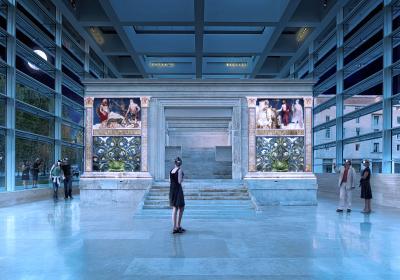Ara Pacis transformed into 360° experience

ROME -- A face-to-face confrontation with Augustus, the Emperor who transformed Rome 2,000 years ago, the Italian Parliament buildings and all the surrounding squares and streets swept away leaving a vast green park, the felling of the sacrificial bull and the burning of the entrails -- all these and more are the new experiences that visitors can now enjoy at the “L'Ara Com'Era” exhibition at the Ara Pacis.
The slick Italian name given to the exhibition translates rather clumsily into English as “The Altar As It Was,” but this explains it all. In fact, through the use of the latest virtual reality technology, the show pilots viewers back to the early years of the Altare della Pace in Imperial Rome, when it symbolized the universal peace achieved through Roman dominance in much of the then known world.
The idea of setting up a regular programme of projecting images of the original colours onto the bare facade of one of Rome's principal monuments was launched at the end of last summer after a few sporadic experimental runs. Despite the limited hours when projections were available (only on evenings at weekends), it drew 11,000 open-mouthed visitors stunned by the revelation of the brilliant colours that originally decorated the bas reliefs -- the glowing reds, periwinkle blues, grass greens and sunny yellows and the purple-trimmed robes of the senators and dignitaries in procession with the Emperor and his family.
Encouraged by the public's enthusiastic reception, the organisers (Zètema Progetto Cultura, a branch of the cultural department of the Municipality of Rome) have now enhanced the experience to create an innovative Augmented Reality and Virtual Reality event through the use of a mixture of techniques. These include computer graphics, 3D and filmed sequences with live actors. The result is a multimedial miracle conjured up by Genoa-based ETT spa, a leading digital creative company with offices in several Italian cities as well as London. To access the experience, visitors wear headphones (five languages available) and a visor device that opens up an Alice in Wonderland view of a long-lost world.
First, Augustus himself steps forward to talk about his achievements. Then our vision pans over the ancient Field of Mars – now the heavily built up centre of Rome. In Augustus' time, it was a vast leafy park, containing only his Altar of Peace, his Mausoleum, the Pantheon, the colonnaded Saepta Julia (where ancient Roman citizens cast their votes) and an aqueduct.
Next thing we know, we are surrounded by a crowd of ancient Roman senators and Vestal Virgins converging on the Altar from both sides to watch the dramatic sequence of the Taurobolium, the sacrifice in which an enormous bull is felled by one hammer blow (not for the squeamish, though teenagers used to video games will no doubt take it in their stride).
After we have witnessed the removal of the entrails from the dead bull and the solemn offering to the gods, the spectacle transforms from the realm of fantasy to scientifically-based reality.
There are nine different stages mapped out for observation, identified by markers on the floor. Following the correct sequence, we circulate round the four sides of the Altar to view the bas-relief panels as they originally appeared, according to the results of modern day analyses of the traces of pigmentation remaining on the stone.
In addition, all the damaged and missing fragments of the carvings and mouldings re-appear in three dimensional form. We can now see the vivid depictions of legends referring to the foundation of Rome, with the arrival of Aeneas, founder of the Roman race, the twins Romulus and Remus nurtured by the wolf, the goddesses Tellus and Roma and many other mythical figures.
The last stage shows the solemn procession of senators with the Emperor and the Imperial family. And all in glorious colour.
The decorative panels underneath the mythological scenes are particularly beautiful. They are filled with a riot of entwined flowers, plants and branches, concealing several animals. Some of the creatures so small that they are almost invisible.
Incredible as it seems, the Altar was lost for centuries, buried under silt from the frequent Tiber floods. In 1879, Friedrich Von Duhn, a young German archaeologist, identified some fragments that had emerged during construction work in the area. However, it wasn't until 1937-38, when the Mussolini government decided to hold celebrations for the Bi-Millennium of Augustus, that the pieces of the monument were recovered, pieced together, restored somewhat clumsily and set within a protective stone pavilion, built by Ballio Morpurgo, a leading architect of the time.
The result was not quite as Augustus would have wanted it. The Altar is orientated in a north-south direction, while its original positioning was east-west, thus facing his Mausoleum.
Some years ago it was decided that the Morpurgo building was no longer suitable and it was replaced by the present museum, designed by American architect Richard Meier.
Note: Visitors are admitted in small groups, so you may find a queue. The visor cannot be used by children under 13.
L'ARA COM'ERA exhibition is open until the 15th April, every Friday and Saturday evening until midnight. From the April 21 until Oct. 30 it will be open every evening, except May 1 National Holiday.
For info and bookings: Tel: 060608 or www.arapacis.it
ms


